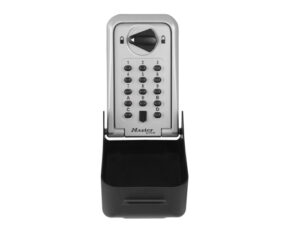 There is a multitude of ways to grant someone access to a building with a sophisticated access control system but for the majority of homes and a large number of businesses it is still a key that is required. In many situations, such as for the care of elderly or for allowing workmen onsite, it is vital that ‘leaving the key out’ is not putting the premises, people and contents at risk. Placing a key under the plant pot or front mat is not a secure option.
There is a multitude of ways to grant someone access to a building with a sophisticated access control system but for the majority of homes and a large number of businesses it is still a key that is required. In many situations, such as for the care of elderly or for allowing workmen onsite, it is vital that ‘leaving the key out’ is not putting the premises, people and contents at risk. Placing a key under the plant pot or front mat is not a secure option.
While plastic boxes and containers disguised as rocks are available these, of course, are hardly the most robust and only delay burglary.
A recent release from Master Lock is the 5426EURD a wall-mounted key lock box under the name Select Access that offers what the organisation claims is the widest internal capacity available.
The zinc-heavy construction is spacious enough to house a number of single keys or multiple key bunches, plus access cards and fobs. The 14-choice keypad is both numerical and alphabetical, meaning that 16,000 combinations are possible to set. Once the correct code has been entered users move an ergonomically-shaped handle to access the storage chamber.
The simple and secure lock box is aimed at ensuring parents and children alike will never have to hide keys under the doormat or a flower pot ever again.
The product has received police accreditation and been awarded both the ‘Sold Secure’ and ‘Secured by Design’ certifications, meaning it has passed stringent testing procedures.
Installation
The unit is supplied fitted to display packaging that is opened by cutting then tearing off the rear information sticker. The fitting screws, internal key hook, recode tool and plastic tray insert are in a panel in the back of the pack. The unit is freed from the package by snipping two retainers. It is at this point that you notice that the packaging itself was not contributing much to the product, it’s all the key safe, weighing in at around 2.8kg.
Fortunately, the unit is supplied with a template for marking out the drill holes, which if not provided could have turned installation into a two-man job as some could find it tricky to hold the heavy unit against the wall and mark the holes at the same time. As is the way with Secured by Design systems they must be fitted as instructed to ensure certification.
First job is to set the code. This can be done when in situ but it is easier to set when it can be manipulated on a desk. The designated code allows any combination of at least four numbers or characters to be used, but each can only be used once. The process is straightforward and involves rotating screws inside the door to “Set On” position. The unit is then ready for fitting.
The unit should be mounted in a discreet place and not where the screws will be drilled into mortar. Using the template, mark out the mounting points and then drill a 3mm pilot hole followed by a 5mm drill for the full hole. All four screws can then be hand tightened before using an 8mm socket to tighten the two bottom screws. With a 3mm gap for the top screws the key hook should be inserted, then fully tighten the top screws. The plastic tray and code tool can then be returned to the unit.
Read the full review in the May 2018 edition of PSI magazine

